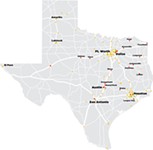Helping Women Helps Texas
Women's Health Program saves Texas money, says report
By Jordan Smith, Fri., July 23, 2010

This just in: Family planning saves money.
That fact is once again borne out in a report prepared last month by the state's Health and Human Services Commission, charged with looking at the annual savings and performance of the Women's Health Program, a Medicaid-waiver program created by state legislators in 2005. The program, a five-year demonstration project that will need to be renewed next year (or folded into whatever changes accompany health care reform), provides family planning services and related health screenings for low-income women ages 18-44 – women who wouldn't otherwise be eligible for Medicaid benefits but who nonetheless lack access to health care.
According to the HHSC report (requested in 2009 by Rep. Mike Villarreal, D-San Antonio), the program saved Texas more than $40 million in state funds in 2008 (the most recent year for which numbers are available) by reducing the number of Medicaid-paid births in the state. More than half of all births in Texas are paid for by Medicaid, and 10% of those are deliveries to teen mothers, ages 13-17, which alone costs the state $41 million, according to the Department of State Health Services. (Moreover, a whopping 70% of pregnancies among Texas' unmarried are unplanned, according to DSHS – a startling statistic that has economic impact far beyond the basic costs to the state's health care system.)
The state put roughly $2 million into the program in 2008, which the federal government matches. That pays for not only annual gynecological exams and access to contraceptives, but also primary screenings for breast and cervical cancer, diabetes, high blood pressure, and sexually transmitted diseases. Clients also receive family planning counseling – including discussion of the "benefits of abstinence." According to HHSC, the investment in the Women's Health Program reduced Medicaid-paid births in 2008 by more than 10,000, for a total savings (federal and state) of more than $92 million. In total, after costs, the state saved more than $40 million – $20 for every $1 invested in the program.
In sum, says Sarah Wheat, director of public affairs for Planned Parenthood of the Texas Capital Region, the program is an "absolute" success and has helped to expand access to health care for thousands of uninsured low-income women. "It's a great program that saves the state huge amounts of money" providing service for "women who weren't eligible for coverage before," she said. And there's great room for improvement: Currently only about 5% of the 2 million women eligible for the program are actually using it. (In Central Texas, the program served 9,607 clients last year.) Among the roughly 88,500 women using the program, 77% were younger than 30, according to HHSC.
Villarreal will be part of the effort to renew the program in 2011 and will also file legislation seeking to expand state outreach and enrollment efforts. "As we struggle with a state budget deficit and sky-high rate of unplanned pregnancies, giving more women the opportunity to enroll in the Women's Health Program is a no-brainer," he said.
Got something to say on the subject? Send a letter to the editor.










